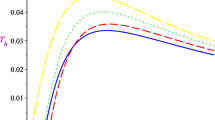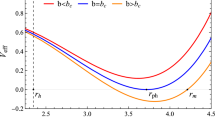Abstract
We study the dependence of the parameters of the evolution of scalarly charged black holes (BHs) in the early Universe on the parameters of field theories of interaction, and the influence of the geometric structure of the relative position of BHs on the limitation of their maximum mass, The problem of the metric of a scalarly charged BH in a medium of expanding scalarly charged matter is discussed, the expression is obtained for the macroscopic cosmological constant at late stages of expansion, generated by quadratic fluctuations of the metric, connecting the cosmological constant value with the BH masses and their concentration.




Similar content being viewed by others
Notes
We use the Planck system of units \(G=c=\hbar=1\).
These are combinations of the equations \({}^{1}_{1}\), \({}^{4}_{4}\) and the scalar field equation.
References
Yu. G. Ignat’ev, Grav. Cosmol. 29 (4), 327 (2023); arXiv: 2308.03192.
S. Gillessen, F. Eisenhauer, S. Trippe, T. Alexander, R. Genzel, F. Martins, and T. Ott, Astrophys. J. 692, 1075 (2009); arXiv: 0810.4674.
Sheperd Doeleman, Jonathan Weintroub, Alan E. E. Rogers, et al., Nature 455, 78 (2008); arXiv: 0809.2442.
Yu. G. Ignat’ev, Grav. Cosmol. 30 (1), 40 (2024); arXiv: 2311.09926.
L. D. Landau and E. M. Lifshitz. The Classical Theory of Fields (Pergamon Press, Oxford, 1971).
I. Z. Fisher, Zh. Eksp. Teor. Fiz. 18, 636 (1948); arXiv: gr-qc/9911008.
K. A. Bronnikov and J. C. Fabris, Phys. Rev. Lett. 96, 251101 (2006); arXiv: gr-qc/0511109.
Kirill A. Bronnikov and Sergey G. Rubin, Lectures on Gravitation and Cosmology (MEPhI, Moscow, 2008) [in Russian].
Kirill A Bronnikov and Sergey G Rubin, Black Holes, Cosmology and Extra Dimensions (World Scientific, Singapore, 2013).
S. Adler and R. B. Pearson, Phys. Rev. D textbf18, 2798 (1978).
Yu. G. Ignat’ev, Grav. Cosmol. 29 (3), 213 (2023); arXiv: 2307.13767.
A. S. Eddington, Mathematical Theory of Relativity (Cambridge Univ. Press, Cambridge, 1923).
O. I. Bogoyavlensky, Methods of the Qualitative Theory of Dynamical Systems in Astrophysics and Gas Dynamics (Nauka, Moscow, 1980).
Yu. G. Ignat’ev, in: Gravitaciya i Teoriya Otnositelnosti, issue 14 (Kazan University Press, Kazan, 1978), p. 90 [in Russian].
Yu. G. Ignat’ev, in: Gravitaciya i Teoriya Otnositelnosti, issue 20 (Kazan University Press, Kazan, 1983), p. 50 [in Russian].
Yu. G. Ignat’ev, Grav. Cosmol. 13, 59 (2007).
Yu. G. Ignat’ev and A. A. Popov, Sov. Phys. J. 32, 391 (1989).
Yu. G. Ignat’ev and A. A. Popov, Actrophys. Space Sci. 163, 153 (1990).
Yu. G. Ignat’ev and A. A. Popov, Phys. Lett. A 220, 22 (1996); arXiv: gr-qc/9604028.
Yu. G. Ignat’ev and N. Elmakhi, Russ. Phys. J. 51, 74 (2008).
Yu. G. Ignat’ev, Grav. Cosmol. 25, 354 (2019); arXiv: 1908.03488.
ACKNOWLEDGMENTS
The author is grateful to the participants of the seminar of the Department of Relativity and Gravity at Kazan University for a useful discussion of some aspects of the work. The author is especially grateful to professors S.V. Sushkov and A.B. Balakin.
Funding
The work was carried out using subsidies allocated as part of state support for the Kazan (Volga Region) Federal University in order to increase its competitiveness among the world’s leading scientific and educational centers.
Author information
Authors and Affiliations
Corresponding author
Ethics declarations
The author of this work declares that he has no conflicts of interest.
Additional information
Publisher’s Note.
Pleiades Publishing remains neutral with regard to jurisdictional claims in published maps and institutional affiliations.
Rights and permissions
About this article
Cite this article
Ignat’ev, Y.G. Formation of Supermassive Nuclei of Black Holes in the Early Universe by the Mechanism of Scalar-Gravitational Instability. III. Large-Scale Picture. Gravit. Cosmol. 30, 141–148 (2024). https://doi.org/10.1134/S0202289324700038
Received:
Revised:
Accepted:
Published:
Issue Date:
DOI: https://doi.org/10.1134/S0202289324700038




